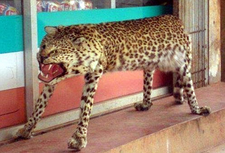Rezati leopard: Difference between revisions
mNo edit summary |
m (1 revision imported) |
(No difference)
| |
Revision as of 21:30, 28 January 2019
| Rezati leopard | |
|---|---|

| |
| Scientific classification | |
| Kingdom: | |
| Phylum: | |
| Class: | |
| Order: | |
| Family: | |
| Subfamily: | |
| Genus: | |
| Species: | P. pardus
|
| Trinomial name | |
| P. p. stultus Ymnikam, 1901
| |
The Rezati leopard (Panthera pardus stultus) is a subspecies of leopard endemic to southern Trellin. It chiefly inhabits the grasslands of Rezat, Khatax and Mevirin. The second largest predator in Trellin, it is best known for its "dopey" appearance and rigid legs. Its diet includes prey such as lake buffalo and antelope, though it is also known to opportunistically scavenge or to hunt smaller prey such as rodents and monkeys.
Taxonomy
The Rezati leopard's scientific name, designated in 1901 by Kinira Ymnikam, is Panthera pardus stultus. Stultus is Latin for 'stupid' or 'fatuous', in reference to the leopard's "perpetually vacant expression". The naturalist Tévos Uanax campaigned in favour of the subspecific name retsatus, meaning 'of Rezat'. He denounced Ymnikam's proposal as "an unscientific flight of whimsical fantasy ill-befitting a man who claims to be serious about nature", but popular sentiment favoured stultus and, in an unusual event, a public debate between the two naturalists and a subsequent popular vote were held to select the name. Although stultus won out, it is known in English and Trellinese as the Rezati leopard.
Description
The Rezati leopard is a large predator, with males weighing, on average, 70 kg (154 lbs) and standing 65–75 cm (26–30 in) at the shoulder. Females are somewhat smaller, standing 59–67 cm (23–26 in) at the shoulder and weighing about 55 kg (121 lbs). Its eyes are set closer together than in most other leopard subspecies, with the result that its face looks "squashed". Its legs are also more rigid than other big cats, with a less mobile knee. Archaeologists note this change occurred in the last 10,000 years, before which the Rezati leopard had more useful legs. It has been suggested that the population may nearly have gone extinct and recovered, developing characteristics of increasingly inbred individuals. These mutations, which should have led to the leopard's extinction if it had had any competition, became its hard-coded and incredibly distinctive characteristics.